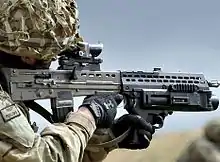Cocking handle
The cocking handle, also known as charging handle or bolt handle, is a device on a firearm which, when manipulated, results in the bolt being pulled to the rear, putting the hammer/striker into a spring-loaded ("cocked") "ready and set" position, allowing the operator to open the breech and eject any spent/unwanted cartridge/shell from the chamber, and then load a new round from the magazine or belt if required. By opening the breech, it also helps the operator to verify that the weapon's chamber is clear of any rounds or other obstructions; to clear a stoppage such as a jam, double-feed, stovepipe or misfire; to facilitate moving the bolt back into battery, acting as a forward assist (but not necessarily); and to release a bolt locked to the rear by a catching mechanism on a firearm equipped with a "last round bolt hold open" (LRBHO) feature.[1]
.jpg.webp)

These devices vary significantly between firearms but may occur in the form of a small protrusion or hook from the side of the bolt, a pumped slide or lever. The slide in a pistol performs a similar action as a cocking handle.[2]

There are also additional factors concerning the design of cocking handles, some of them are especially important if the weapon is for tactical use. One issue is the mean time between failures due to metal fatigue. Just like other parts, cocking handles sometimes break when weapons are heavily used.[3] Another issue is whether the cocking handle is sufficiently large for use by someone wearing heavy gloves and protective clothing. Some weapons are designed with thumb grooves for extra grip when cocking a weapon to prevent releasing it before it has been pulled back all the way, such as the British SA80 family of rifles.
Cocking handles can be reciprocating or non-reciprocating. The advantage of the former is that it gives the user complete control over the movement of the bolt and bolt carrier. It enables great force to be used to chamber or extract difficult or ruptured cartridges. However, it adds an extra, fast-moving part on the outside of the gun and may limit the way the gun is handled.[4]
See also
References
- "How a Handgun Works: 1911 .45". AnimaGraffs. Retrieved 2015-08-06.
- Patrick Sweeney (3 December 2009). Gunsmithing - Pistols and Revolvers. Gun Digest Books. pp. 171–172. ISBN 1-4402-0389-X.
- Chris McNab; Hunter Keeter (2008). Tools of Violence: Guns, Tanks and Dirty Bombs. Osprey Publishing. pp. 23–. ISBN 978-1-84603-225-7.
- "What are the advantages of a reciprocating charging handle vs non-reciprocating?". Reddit Guns. Retrieved 2015-08-06.